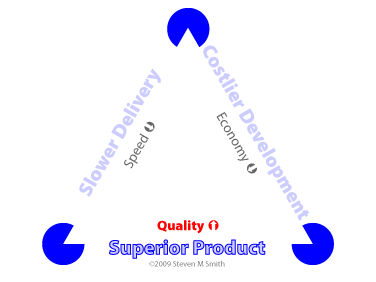What typically happens when product development decides to create a superior product? The most likely result is 1. slower delivery or 2. costlier development or 3. both slower delivery and costlier development. Why?

You don’t get something for nothing.
Producing a higher quality product takes more development time, which delays delivery to the customer and drives up development costs. For instance, if you buy tailor made clothing, you receive a superior product. But the garment will cost you much more than off the rack clothing and you will typically wait weeks before you can wear the item. It simply takes more time for a tailor to create the customized garment. And that time and expertise increases the cost and delays the delivery.
This triangular relationship is a general law of development (for more information see Jerry (Gerald M.) Weinberg’s terrific book Quality Software Management Vol. 4: Anticipating Change). Increase one of the variables — quality, speed, or economy — and one or both of the other two variables decreases. Every decision about these variables is a decision that involves making a trade-off.
Beware of the typical reaction of management to compensate for this effect by adding more people to the project, especially when the people are added late. It’s highly likely this action will elongate the delivery rather than shorten it.
Unless changes are made to the development process and those changes work as planned, I suggest you make sure that your customer believes in the value you intend to produce. Don’t lose the customer you are trying to please. Negotiate a scorecard with your customer to assess the value of your product plans rather than assuming you know. Development cost and speed are part of that scorecard.
Please also see my related post Trade-off: Go For Speed.
A slight twist to this is:
(1) improve quality (fewer errors)
(2) reduce the number of features
(3) keep cost and schedule the same
Not easy to do though
Dwayne, I agree that it’s not easy to do.
Thank you for sharing that approach.
I see that approach used regularly. It does enable the possibility of keeping cost and schedule the same by reducing the amount of work that needs to be done. And you are right — it’s not easy.
I would recommend this approach if the customers whose opinions mattered the most agreed the integration of all the changes resulted in higher quality.
A more optimistic presentation.
Even if I fully agree on the approach (it’s often something that I present), one trade-off can be that one of the product gain can improve the global process and thus make you gain time/cost.
By thinking at his concept from the beginning, you can try to design your better product in order to increase also your process to create it
Thank you, Laurent.
I appreciate you for sharing your thoughts.
I interpret you advocate being conscious of this general law from the beginning.
As long as the long-term process improvement plan is based on sound logic rather than fantasy, the concept makes sense to me.